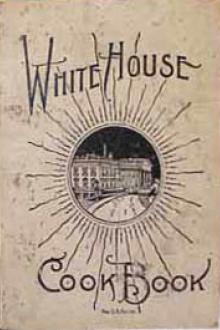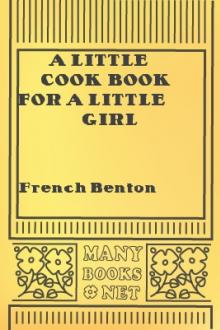The Whitehouse Cookbook (1887), Hugo Ziemann [world of reading .TXT] 📗

- Author: Hugo Ziemann
- Performer: -
Book online «The Whitehouse Cookbook (1887), Hugo Ziemann [world of reading .TXT] 📗». Author Hugo Ziemann
THAWING FROZEN MEAT, ETC.
If meat, poultry, fish, vegetables, or any other article of food, when found frozen, is thawed by putting it into warm water or placing it before the fire, it will most certainly spoil by that process, and be rendered unfit to eat. The only way to thaw these things is by immersing them in cold water. This should be done as soon as they are brought in from market, that they may have time to be well thawed before they are cooked. If meat that has been frozen is to be boiled, put it on in cold water. If to be roasted, begin by setting it at a distance from the fire, for if it should not chance to be thoroughly thawed all through to the centre, placing it at first too near the fire will cause it to spoil. If it is expedient to thaw the meat or poultry the night before cooking, lay it in cold water early in the evening, and change the water at bed-time. If found crusted with ice in the morning, remove the ice, and put the meat in fresh cold water, letting it lie in it till wanted for cooking.
Potatoes are injured by being frozen. Other vegetables are not the worse for it, provided they are always thawed in cold water.
TO KEEP MEAT FROM FLIES.
Put in sacks, with enough straw around it so the flies cannot reach through. Three-fourths of a yard of yard-wide muslin is the right size for the sack. Put a little straw in the bottom, then put in the ham and lay straw in all around it; tie it tightly and hang it in a cool, dry place. Be sure the straw is all around the meat, so the flies cannot reach through to deposit the eggs. (The sacking must be done early in the season before the fly appears.) Muslin lets the air in and is much better than paper. Thin muslin is as good as thick, and will last for years if washed when laid away when emptied.
ROAST BEEF.
One very essential point in roasting beef is to have the oven well heated when the beef is first put in; this causes the pores to close up quickly, and prevents the escape of the juices.
Take a rib piece or loin roast of seven or eight pounds. Wipe it thoroughly all over with a clean wet towel. Lay it in a dripping-pan, and baste it well with butter or suet fat. Set it in the oven. Baste it frequently with its own drippings, which will make it brown and tender. When partly done season with salt and pepper, as it hardens any meat to salt it when raw, and draws out its juices, then dredge with sifted flour to give it a frothy appearance. It will take a roast of this size about two hours' time to be properly done, leaving the inside a little rare or red—half an hour less would make the inside quite rare. Remove the beef to a heated dish, set where it will keep hot; then skim the drippings from all fat, add a tablespoonful of sifted flour, a little pepper and a teacupful of boiling water. Boil up once and serve hot in a gravy boat.
Some prefer the clear gravy without the thickening. Serve with mustard or grated horse-radish and vinegar.
YORKSHIRE PUDDING.
This is a very nice accompaniment to a roast of beef; the ingredients are, one pint of milk, four eggs, whites and yolks beaten separately, one teaspoonful of salt, and two teaspoonfuls of baking powder sifted through two cups of flour. It should be mixed very smooth, about the consistency of cream. Regulate your time when you put in your roast, so that it will be done half an hour or forty minutes before dishing up. Take it from the oven, set it where it will keep hot. In the meantime have this pudding prepared. Take two common biscuit tins, dip some of the drippings from the dripping-pan into these tins, pour half of the pudding into each, set them into the hot oven, and keep them in until the dinner is dished up; take these puddings out at the last moment and send to the table hot. This I consider much better than the old way of baking the pudding under the meat.
BEEFSTEAK. No. 1.
The first consideration in broiling is to have a clear, glowing bed of coals. The steak should be about three-quarters of an inch in thickness, and should be pounded only in extreme cases, i.e., when it is cut too thick and is "stringy." Lay it on a buttered gridiron, turning it often, as it begins to drip, attempting nothing else while cooking it. Have everything else ready for the table; the potatoes and vegetables dished and in the warming closet. Do not season it until it is done, which will be in about ten to twelve minutes. Remove it to a warm platter, pepper and salt it on both sides and spread a liberal lump of butter over it. Serve at once while hot. No definite rule can be given as to the time of cooking steak, individual tastes differ so widely in regard to it, some only liking it when well done, others so rare that the blood runs out of it. The best pieces for broiling are the porterhouse and sirloin.
BEEFSTEAK. No. 2.
Take a smooth, thick-bottomed frying pan, scald it out with hot water, and wipe it dry; set it on the stove or range, and when very hot, rub it over the bottom with a rag dipped in butter; then place your steak or chops in it, turn often until cooked through, take up on a warm platter, and season both sides with salt, pepper and butter. Serve hot.
Many prefer this manner of cooking steak rather than broiling or frying in a quantity of grease.
BEEFSTEAK AND ONIONS.
Prepare the steak in the usual way. Have ready in a frying pan a dozen onions cut in slices and fried brown in a little beef drippings or butter. Dish your steak, and lay the onions thickly over the top. Cover and let stand five minutes, then send to the table hot.
BEEFSTEAK AND OYSTERS.
Broil the steak the usual way. Put one quart of oysters with very little of the liquor into a stewpan upon the fire; when it comes to a boil, take off the scum that may rise, stir in three ounces of butter mixed with a tablespoonful of sifted flour, let it boil one minute until it thickens, pour it over the steak. Serve hot.
TO FRY BEEFSTEAKS.
Beefsteak for frying should be cut much thinner than for broiling. Take from the ribs or sirloin and remove the bone. Put some butter or nice beef dripping into a frying pan and set it over the fire, and when it has boiled and become hot lay in the steaks; when cooked quite enough, season with salt and pepper, turn and brown on both sides. Steaks when fried should be thoroughly done. Have ready a hot dish, and when they are done take out the steaks and lay them on it, with another dish cover the top to keep them hot. The gravy in the pan can be turned over the steaks, first adding a few drops of boiling water, or a gravy to be served in a separate dish made by putting a large tablespoonful of flour into the hot gravy left in the pan after taking up the steaks. Stir it smooth, then pour in a pint of cream or sweet rich milk, salt and pepper, let it boil up once until it thickens, pour hot into a gravy dish and send to the table with the steaks.
POT ROAST. (Old Style.)
This is an old-fashioned dish, often cooked in our grandmothers' time. Take a piece of fresh beef weighing about five or six pounds. It must not be too fat. Wash it and put it into a pot with barely sufficient water to cover it. Set it over a slow fire, and after it has stewed an hour salt and pepper it. Then stew it slowly until tender, adding a little onion if liked. Do not replenish the water at the last, but let all nearly boil away. When tender all through take the meat from the pot and pour the gravy in a bowl. Put a large lump of butter in the bottom of the pot, then dredge the piece of meat with flour and return it to the pot to brown, turning it often to prevent its burning. Take the gravy that you have poured from the meat into the bowl and skim off all the fat; pour this gravy in with the meat and stir in a large spoonful of flour wet with a little water; let it boil up ten or fifteen minutes and pour into a gravy dish. Serve both hot, the meat on a platter. Some are very fond of this way of cooking a piece of beef which has been previously placed in spiced pickle for two or three days.
SPICED BEEF. (Excellent.)
For a round of beef weighing twenty or twenty-four pounds, take one-quarter of a pound of saltpetre, one-quarter of a pound of coarse brown sugar, two pounds of salt, one ounce of cloves, one ounce of allspice and half an ounce of mace; pulverize these materials, mix them well together, and with them rub the beef thoroughly on every part; let the beef lie for eight or ten days in the pickle thus made, turning and rubbing it every day; then tie it around with a broad tape, to keep it in shape; make a coarse paste of flour and water, lay a little suet finely chopped over and under the beef, inclose the beef entirely in the paste, and bake it six hours. When you take the beef from the oven, remove the paste, but do not remove the tape until you are ready to send it to the table. If you wish, to eat the beef cold, keep it well covered that it may retain its moisture.
BEEF Á LA MODE.
Mix together three teaspoonfuls of salt, one of pepper, one of ginger, one of mace, one of cinnamon, and two of cloves. Rub this mixture into ten pounds of the upper part of a round of beef. Let this beef stand in this state over night. In the morning, make a dressing or stuffing of a pint of fine bread crumbs, half a pound of fat salt pork cut in dice, a teaspoonful of ground thyme or summer savory, two teaspoonfuls sage, half a teaspoonful of pepper, one of nutmeg, a little cloves, an onion minced fine, moisten with a little milk or water. Stuff this mixture into the place from whence you took out the bone. With a long skewer fasten the two ends of the beef together, so that its form will be circular, and bind it around with tape to prevent the skewers giving way. Make incisions in the beef with a sharp knife; fill these incisions very closely with the stuffing, and dredge





Comments (0)